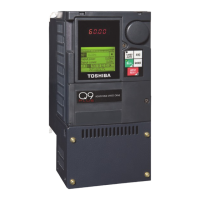Alarms, Trips, and Troubleshooting
Q9 Plus ASD Install/Op Manual
264 https://www.toshiba.com/tic/
Alarms
An Alarm is an indication that there is a system
operating limit that is being exceeded and that a
Fault may be imminent (not all ongoing alarms
result in a fault) or to provide an indication that an
operator error has occurred. An Alarm may be
associated with an output terminal to notify the
operator of the condition remotely, close a contact,
or to engage a brake. At the least, an Alarm will
cause an alarm code to appear on the EOI display
The active alarm may be displayed on the Alarm
screen — some alarms are displayed on the
Frequency Command screen. Press the Mode key if
the alarm is displayed on the Frequency Command
screen to scroll to the Alarm screen.
Table 17 lists the Alarm codes that may be
displayed during operation of the Q9 Plus ASD.
Each alarm code listed is accompanied by a
description and a possible cause. In the event that
the source of the malfunction cannot be
determined, contact the TIC Customer Support
Center for further information on the condition and
for an appropriate course of action.
In the event that multiple alarms are activated, only
the first to be detected will be displayed.
Alarm
Table 17. Alarms.
LED
Screen
LCD
Screen
Alarm Description Possible Cause
* Reset ignored if active.
4-20 mA 4-20 mA 4-20 Signal Loss.
• Misconnection, poor connection, or broken wire.
• Improper programming at F201 and associated
parameters.
AbFL
Low Suction/No
Flow Cut Off
Running ASD producing
no flow.
• Low Suction/No-Flow Alarm enabled at F450.
• Loss of suction pressure or closed pump output
valve.
• Activated discrete input terminal set to Low
Suction/No Flow Protection.
• Pump cavitation.
• ASD Upper-Limit Frequency run-time is equal to
F484 time setting.
CM1 Comm Error
Communication Error
Interruption.
• Improperly programmed ASD.
• Improper communications settings.
• Improperly connected cables.
CM2 Comm Error 2 Communication Error.
DAMP Damp Damper Closed.
• Improper configuration/programming for
Damper Control at discrete input terminals.
• Damper motor failure.
• Damper position switch failure.
E Emergency Off Emergency Off.
• Stop-Reset was pressed twice at the EOI.
• E-OFF command was received remotely.
HLD Heavy Load Motor/ASD Over Loaded.
• Acceleration time is too short.
• ASD is improperly matched to the application.
• Excessive load.
LLD Light Load Light Load. • ASD is improperly matched to the application.
* Reset ignored if active.

